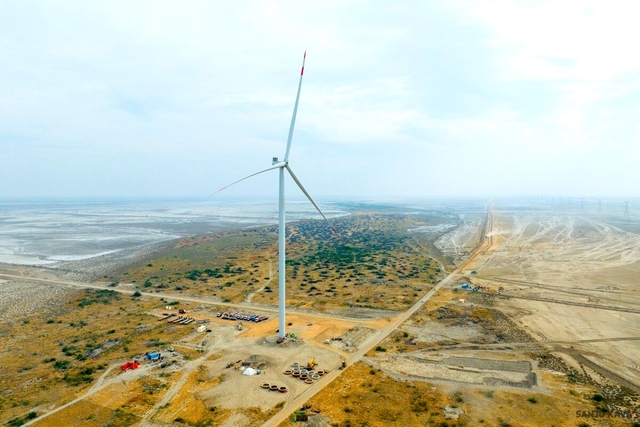Infrastructure
From Barren Airstrip To World's Largest Renewable Energy Park: Khavda's Remarkable Journey

Khavda Renewable Energy Park, Gujarat.
In a stunning metamorphosis, a once desolate airstrip located in a remote expanse near the Pakistan border is poised to become the launchpad for one of the world's most expansive renewable energy parks.
This unlikely site, equipped only with basic amenities like a portable toilet and a makeshift office, has evolved to become the entry point for the sprawling Khavda renewable energy park, showcasing India's commitment to renewable energy innovation.
Adani's Vision: Transforming Arid Terrain Into Renewable Energy Hub
Gautam Adani, head of the Adani Group and formerly the world's second-richest person, landed at this isolated airstrip in December 2022. Situated amidst miles of arid land without even a pincode, the area was initially deemed unsuitable for development.
However, beneath its barren exterior lies a wealth of renewable energy potential. An 18-kilometre drive from the airstrip leads to the Khavda renewable energy park, spreading over 538 square kilometres — roughly five times the size of Paris.
The region, boasting the country's second-best solar radiation and wind speeds five times that of the plains, has been transformed with solar panels, wind turbines, worker colonies, desalination plants, and even mobile phone repair shops, reports NDTV.
Vneet Jaain, managing director of Adani Green Energy, unveiled the company's ambitious plans for Khavda. An investment of around Rs 1.5 lakh crore is earmarked to generate 30 megawatts of clean electricity. With 2,000 MW already commissioned, the company plans to add 4 GW this fiscal year and 5 GW annually thereafter.
Challenges And Triumphs: Overcoming Barriers In A Remote Landscape
The remote airstrip, crucial for ferrying Adani Group executives from Mundra or Ahmedabad, operates without a dedicated air traffic controller. Pilots navigate using visual aids and communicate their plans with the Bhuj ATC over the phone, located 160 km away.
Despite its proximity to the international border with Pakistan, the Khavda park maintains a buffer zone patrolled by the Border Security Force (BSF). The airstrip's construction, completed in just 35 days, highlights the challenges faced, including the need to modify tractors for the challenging terrain.
Khavda's ambitious goal is to generate 500 GW of electricity from non-fossil sources by 2030. At its peak, the park is projected to produce 81 billion units of electricity, equivalent to powering entire nations.
Jaain detailed the composition of the planned 30 GW capacity at Khavda, consisting of 26 GW solar and 4 GW wind power. The project's comprehensive development includes extensive infrastructure construction, environmental assessments, and feasibility studies over the past five years.
As Khavda continues its transformation from barren land to a renewable energy powerhouse, it stands as a testament to India's innovation and determination in addressing the urgent challenges of climate change and energy transition.
Support Swarajya's 50 Ground Reports Project & Sponsor A Story
Every general election Swarajya does a 50 ground reports project.
Aimed only at serious readers and those who appreciate the nuances of political undercurrents, the project provides a sense of India's electoral landscape. As you know, these reports are produced after considerable investment of travel, time and effort on the ground.
This time too we've kicked off the project in style and have covered over 30 constituencies already. If you're someone who appreciates such work and have enjoyed our coverage please consider sponsoring a ground report for just Rs 2999 to Rs 19,999 - it goes a long way in helping us produce more quality reportage.
You can also back this project by becoming a subscriber for as little as Rs 999 - so do click on this links and choose a plan that suits you and back us.
Click below to contribute.
Latest